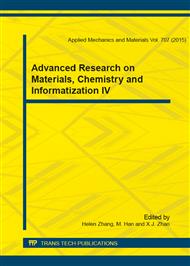[1]
D, Li, et al.: The effects of biochar on growth and uptake of nitrogen and phosphorus for Chinese cabbage in poor quality soil in Ningxia. Acta Scientiae Circumstantiae, Vol. 34(2019), pp.2384-2391. In Chinese.
Google Scholar
[2]
J. Lehmann, et al.: Bio-char sequestration in terrestrial ecosystems – a review. Mitigation and Adaptation Strategies for Global Change, Vol. 11(2006), pp.395-419.
DOI: 10.1007/s11027-005-9006-5
Google Scholar
[3]
Z. Wang, et al.: Characterization and influence of biochars on nitrous oxide emission from agricultural soil. Environmental Pollution, Vol. 174(2013), pp.289-296.
DOI: 10.1016/j.envpol.2012.12.003
Google Scholar
[4]
H. Zheng, et al.: Impacts of adding biochar on nitrogen retention and bioavailability in agricultural soil. Geoderma, Vol. 206(2013), pp.32-39.
DOI: 10.1016/j.geoderma.2013.04.018
Google Scholar
[5]
H. Zheng, et al.: Characteristics and nutrient values of biochars produced from giant reed at different temperatures. Bioresour Technol, Vol. 130(2013), pp.463-471.
DOI: 10.1016/j.biortech.2012.12.044
Google Scholar
[6]
Z. Wang, et al.: Effect of peanut hull biochar on amelioration of typical orchard acidic soil in northern China. Periodical of Ocean University of China, Vol. 43(2013), pp.86-91. In Chinese.
Google Scholar
[7]
Zheng, H., et al.: Sorption of antibiotic sulfamethoxazole varies with biochars produced at different temperatures. Environmental Pollution, Vol. 181(2013), pp.60-67.
DOI: 10.1016/j.envpol.2013.05.056
Google Scholar
[8]
Z. Wang, et al.: Adsorption of Cd(II) varies with biochars derived at different pyrolysis temperatures. Environmental Science, accepted. In Chinese.
Google Scholar
[9]
X. Zhao, et al.: Does biochar addition influence the change points of soil phosphorus leaching? Journal of Integrative Agriculture, Vol. 13(2014), pp.499-506.
DOI: 10.1016/s2095-3119(13)60705-4
Google Scholar
[10]
T. Qian, et al.: Effects of environmental conditions on the release of phosphorus from biochar. Chemosphere, Vol. 93(2013), p.2069-(2075).
DOI: 10.1016/j.chemosphere.2013.07.041
Google Scholar
[11]
K. Chan, et al.: Agronomic values of greenwaste biochar as a soil amendment. Australian Journal of Soil Research, Vol. 45(2007), pp.629-634.
DOI: 10.1071/sr07109
Google Scholar
[12]
K.A. Spokas, et al.: Biochar: A synthesis of its agronomic impact beyond carbon sequestration. Journal of Environmental Quality, Vol. 41 (2011): pp.973-989.
Google Scholar
[13]
G.A. Verheijen F, et al.: Biochar Application to Soils: A Critical Scientific Review of Effects on Soil Properties, Processes and Functions (M). Ispra, Italy: Joint Research Centre.
Google Scholar


